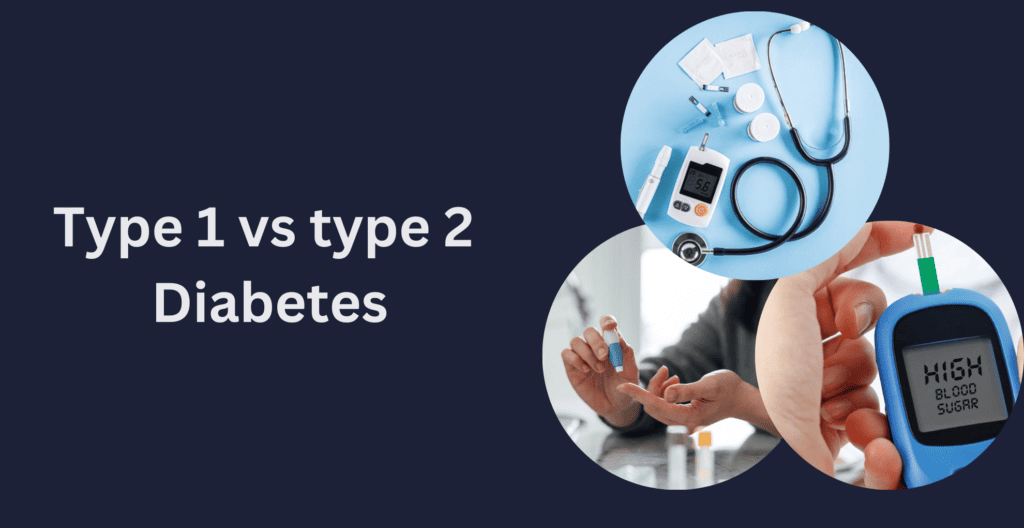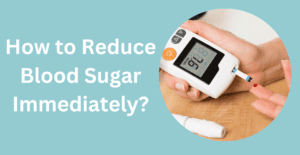We all are aware of diabetes and it has become a very common disease in today’s time. Researches suggest that around 537 million adults around the world have diabetes. Diabetes meaning goes beyond just high blood sugar levels because it can lead to a variety of issues affecting organs such as the heart, kidneys, eyes, and nerves. What do we mean by type 1 vs type 2 diabetes? Are there any categories and types of diabetes and how can you control your diabetes or help your friends and family to the same? We are going to these questions here, you will know everything about type 1 vs type 2 diabetes.
Type 1 Diabetes
Do you know which factors are responsible for Type 1 diabetes? Well, it is genetic. Type 1 diabetes is a chronic autoimmune disorder that affects how your body manages blood sugar (glucose). It is also known as insulin-dependent diabetes or juvenile diabetes. In a healthy person, the pancreas generates insulin. However, in persons with type 1 diabetes, the immune system wrongly targets and destroys the pancreatic insulin-producing cells known as beta cells. As a result, the pancreas produces little insulin, resulting in excessive blood glucose levels and a lack of energy in the cells. If not appropriately handled, this can lead to various symptoms and consequences.
As we discuss all the major differences between type 1 vs type 2 diabetes, you can also check out some diabetes products if you are willing to try and use them. One of the difference between type 1 and 2 diabetes is that people with type 1 diabetes regularly monitor their blood sugar levels and adjust insulin doses accordingly, whereas those with type 2 diabetes may be able to manage their condition through weight management, diet modifications, and exercise.
Type 2 Diabetes
We are talking about type 1 vs type 2 diabetes, and if the type 2 diabetes condition is not managed properly it can lead to various health complications. It’s crucial to understand that there are some differences between type 1 and type 2 diabetes. Type 2 diabetes is a chronic metabolic illness characterized by excessive blood sugar (glucose) levels caused by the body’s inability to produce insulin efficiently. Insulin is a pancreatic hormone that regulates the uptake of glucose into cells, where it is used for energy. In type 2 diabetes, the body’s cells become resistant to the effects of insulin, and the pancreas may be unable to generate enough insulin to compensate. You can read some diabetes blogs to gain more knowledge.
What is the difference between Type 1 and Type 2 Diabetes?
The difference between type 1 and 2 diabetes is that type 1 diabetes is influenced by genetic factors, but type 2 diabetes is influenced by lifestyle factors such as obesity, sedentary behavior, and poor nutritional habits. Here are some of the key differences between type 1 vs type 2 diabetes, you can find them in the table below-
| Factors | Type 1 Diabetes | Type 2 Diabetes |
| Cause | Type 1 diabetes is an autoimmune disease in which the immune system mistakenly destroys the beta cells. | In type 2 diabetes the body’s cells do not respond adequately to insulin. The pancreas may also generate less insulin over time. |
| Onset | It often develops in childhood or early adulthood, but it can occur at any age. | It usually manifests itself in adults, but due to increased obesity rates, it is increasingly being diagnosed in children. |
| Symptoms | Increased thirst, frequent urination, intense hunger, weight loss, weariness, and blurred eyesight. | Symptoms are similar to Type 1 diabetes and can include increased thirst, frequent urination, fatigue, and blurred vision. |
| Insulin Dependency Type | Type 1 diabetes patients are completely reliant on insulin injections or an insulin pump to control their blood sugar levels. | Type 2 diabetes patients may not require insulin in the early stages. They can control their illness with lifestyle adjustments, oral drugs, and, in certain cases, injectable medications. |
| Treatment | Treatment entails regular monitoring of blood sugar levels, carbohydrate counting, and eating a balanced diet, in addition to insulin injections. | Treatment consists of a combination of lifestyle changes such as weight loss, a good diet, and regular physical activity. |
What happens when you have type 1 and type 2 diabetes?
Now that we have answered the basic questions related to type 1 vs type 2 diabetes and also mentioned the differences between type 1 and type 2 diabetes, we need to understand the effect that it has on our body. Once you understand in detail the causes and effects then you can work better to minimize the repercussions of the condition. Understanding the difference between type 1 and type 2 diabetes is critical for the correct diagnosis, treatment, and management of these chronic illnesses to improve the quality of life for diabetics. You should also read about some diabetes success stories to gather some motivation.
EFFECTS OF TYPE 1 DIABETES
Here are a few short-term and long-term effects of Type 1 diabetes-
SHORT-TERM EFFECTS
- Hyperglycemia- It is characterized by symptoms such as increased thirst, frequent urination, lethargy, and impaired vision.
- Ketoacidosis- It occurs when the body is unable to use glucose for energy and instead begins to break down fat for energy. This can also result in the creation of ketones, which can progress to diabetic ketoacidosis (DKA), a potentially fatal illness characterized by nausea, vomiting, stomach pain, and fruity-smelling breath.
LONG-TERM EFFECTS
- Cardiovascular Complications: Talking about type 1 and type 2 diabetes. Type 1 diabetes raises the risk of cardiovascular disease, such as coronary artery disease, heart attack, stroke, and high blood pressure.
- Nerve Damage (Neuropathy): Excessive blood sugar levels can damage nerves, causing symptoms such as numbness, tingling, and pain in the feet and legs.
EFFECTS OF TYPE 2 DIABETES
Here are the short-term and long-term effects of Type 2 diabetes-
SHORT-TERM EFFECTS
- High Blood Sugar (Hyperglycemia): Elevated blood sugar levels are a defining feature of type 2 diabetes. It can cause symptoms like thirst, frequent urination, weariness, and impaired vision. You should gather some information on how to control sugar and plan your diet accordingly.
- Cardiovascular Complications: Type 2 diabetes increases the risk of heart disease, stroke, and high blood pressure. Elevated blood sugar levels can damage blood vessels over time, causing atherosclerosis (artery narrowing and hardening) and raising the risk of cardiovascular events.
LONG-TERM EFFECTS
- Kidney damage-Diabetes can cause damage to the blood vessels in the kidneys, decreasing their ability to filter waste and excess fluids from the blood. This can lead to renal failure in the long run.
- Eye Complications-High blood sugar levels can harm the blood vessels in the eyes, potentially leading to diabetic retinopathy, which can cause vision issues and also blindness if not treated properly.
Are there different risk factors for type 1 and type 2?
After understanding the differences between type 1 and type 2 diabetes and also the effects, let’s also look at the risk factors. The risk factors for type 1 and type 2 diabetes are not the same, however, there are some common risk factors for both type 1 and type 2 diabetes. While both type 1 and type 2 diabetes are caused by hereditary factors, they have different underlying causes and are impacted by different risk factors. Type 1 diabetes is an autoimmune disorder, whereas type 2 diabetes is mostly caused by insulin resistance and lifestyle factors. It is critical to seek personalized guidance and risk assessment from a healthcare expert. You can also check out some diabetes plans online.
Risk Factors for Type 1 Diabetes
Here are the risk factors for type 1 diabetes-
Genetics: The risk is increased by a family history of type 1 diabetes. The likelihood is increased if a parent or sibling has the illness.
Autoimmune conditions- Type 1 diabetes is more likely to develop in those with other autoimmune conditions such as Hashimoto’s thyroiditis, celiac disease, or Addison’s disease.
Environmental Factors: Some infections have been related to a higher risk of developing type 1 diabetes. These viruses may cause an immunological reaction that results in the eradication of insulin-producing cells.
Risk Factors for Type 2 Diabetes-
Here are the risk factors for type 2 diabetes-
Obesity or Excess Weight: One of the biggest risk factors for type 2 diabetes is being overweight or obese. Insulin resistance is influenced by excess body fat, particularly abdominal fat.
Physical inactivity: Type 2 diabetes is more likely to develop in people who lead sedentary lives and engage in little to no physical activity.
Unhealthy Diet: Diets that are high in processed sweets, bad fats, and low in fiber can raise the risk of insulin resistance and diabetes.
We have given you the different risk factors for type 1 vs type 2 diabetes, go through this table to look at all the crucial and different risk factors for type 1 and type 2 diabetes-
|
Type 1 Diabetes |
Type 2 Diabetes |
| Genetics |
Obesity or excess weight environmental |
|
factors physical |
Inactivity |
| Autoimmune conditions |
Unhealthy diet |
|
Viral infections |
High blood pressure |
| Age |
Age |
Are Symptoms of Type 1 and Type 2 Diabetes Different?
Wondering if the symptoms of these two types of diabetes are different or not? Yes, there are different symptoms of these diabetes types. They both involve the control of blood- sugar levels but have different symptoms. Once you know its symptoms and want to bring some changes you can also make a diabetic diet chart with the help of a professional. Read below to know the different symptoms of type 1 and type 2 diabetes:-
Symptoms of Type 1 Diabetes-
Here are the symptoms of type 1 diabetes–
Rapid Onset: Although it can happen at any age, type 1 diabetes typically develops quickly, frequently in childhood or adolescence.
Autoimmune condition- It is an autoimmune illness in which the immune system unintentionally targets and kills the pancreatic cells that make insulin. As a result, Type 1 diabetics need to control their blood sugar with insulin injections or an insulin pump.
Common symptoms- Type 1 diabetes is characterised by several symptoms which include acute hunger, frequent urination, excessive thirst, and exhaustion. These signs can appear suddenly and within a short time.
Symptoms of Type 2 Diabetes-
Here are the symptoms of type 2 diabetes–
Gradual Onset- Type 2 diabetes normally develops gradually, frequently in maturity. It is intimately related to lifestyle variables like obesity, inactivity, and unhealthy eating.
Insulin Resistance-Type 2 diabetes occurs when the body develops a resistance to the effects of insulin. Over time, the pancreas may not generate enough insulin to keep blood sugar levels within normal range.
Common Symptoms-Increased thirst, frequent urination, lethargy, hazy vision, sluggish wound healing, and recurrent infections are all signs of type 2 diabetes. In comparison to Type 1 diabetes, these symptoms may be milder and manifest more gradually.
We have given you the different symptoms for type 1 vs type 2 diabetes, go through this table to look at all the crucial and different symptoms for type 1 and type 2 diabetes-
|
Type 1 Diabetes |
Type 2 Diabetes |
| Rapid Onset |
Gradual Onset |
|
Acute hunger |
Lethargy |
| Excessive thirst |
Hazy Vision |
|
Frequent Urination |
Recurrent Infections |
What are the Complications of Type 1 and Type 2 Diabetes?
When we talk about diabetes diagnosis and treatment we should also know about its complications. There are several differences between type 1 vs type 2 diabetes, similarly, the complications of type 1 diabetes and type 2 diabetes are different. However there are some common factors that are present in both. Now that you have understood the difference between type 1 and 2 diabetes, type 1 diabetes is more frequent in childhood or adolescence and requires insulin injections for survival, whereas Type 2 diabetes is more common in adults and can be treated with lifestyle changes, oral medicines, or insulin injections. We will tell you in detail about the complications of both these types. Type 1 and Type 2 diabetes are chronic metabolic disorders that can lead to various complications if not controlled properly.
Complications of Type 1 Diabetes
There are differences between type 1 and type 2 diabetes based on complications. Here are the complications of type 1 diabetes-
Hypoglycemia- People with Type 1 diabetes who take too much insulin or don’t eat enough carbohydrates run the risk of developing low blood sugar levels (hypoglycemia).
Diabetic Ketoacidosis –When the body doesn’t have enough insulin to handle glucose, the breakdown of fats for energy results in the buildup of ketones and the potentially fatal condition known as diabetic ketoacidosis (DKA).
Cardiovascular Complications-Heart disease, stroke, and high blood pressure are all more common in those with Type 1 diabetes.
Diabetic neuropathy – It is caused by high blood sugar levels damaging the nerves. As a result, the extremities may experience pain, tingling, numbness, or even loss of sensation.
Complications of Type 2 Diabetes
Here are the complications of type 2 diabetes-
Cardiovascular complications- Type 2 diabetes raises the risk of heart disease, stroke, and high blood pressure, just like Type 1 diabetes does.
Hypoglycemia-People with Type 2 diabetes who are taking specific drugs (such as sulfonylureas or insulin) could develop hypoglycemia.
Nephropathy– renal damage, a frequent consequence of Type 2 diabetes that can lead to renal failure, is known as nephropathy.
Neuropathy- Diabetes type 2 patients are also at risk for developing diabetic neuropathy, which damages the nerves and causes accompanying symptoms.
We have given you the different complications for type 1 vs type 2 diabetes, go through this table to look at all the crucial and different complications for type 1 and type 2 diabetes-
|
Type 1 Diabetes |
Type 2 Diabetes |
| Hypoglycemia |
Cardiovascular complications- |
|
Diabetic Ketoacidosis |
Hypoglycemia |
| Cardiovascular Complications- |
Nephropathy |
|
Diabetic neuropathy |
Neuropathy |
Can type 1 or type 2 diabetes be cured or prevented?
There is no known type 1 diabetes treatment. The immune system of the body targets and kills the insulin-producing cells of the pancreas in type 1 diabetes, an autoimmune illness. For the rest of their lives, type 1 diabetics must take insulin therapy to control their blood sugar levels. There are differences between type 1 and type 2 diabetes based on treatment.
On the other hand, type 2 diabetes treatment is frequently linked to lifestyle elements like nutrition, exercise, and weight management. Type 2 diabetes can frequently be managed and even prevented by making good lifestyle choices, even though it may not always be entirely cured. Better blood sugar management and, in some circumstances, type 2 diabetes remission can be achieved by losing extra weight, eating a balanced diet, exercising regularly, and reducing stress.
Conclusion
Type 1 diabetes and type 2 diabetes are both conditions that need to be well- managed and a person should take proper care and precautions. The major difference between type 1 and type 2 diabetes is that type 1 diabetes is genetic and for their whole life type 1 diabetes patient must take insulin therapy to control their blood sugar levels. Whereas lifestyle factors are responsible for type 2 diabetes and you can control the condition by bringing changes in your lifestyle and routine. If you would want to incorporate some of the healthier practices in your life, begin by eating right! You can also try some diabetes recipes for the same. Here we have told you about the effects, symptoms, complications and risk factors of both the type of diabetes and you have got a detailed idea about how it happens and what are the ways to control the same.
FAQs
Which is more serious type 1 or type 2 Diabetes?
There are differences between type 1 and type 2 diabetes. If type 1 or type 2 diabetes is not properly identified, it can have very dangerous side effects. There is no more serious or less serious one. Both illnesses need to be managed with caution and awareness.
Is It Possible for Type 2 Diabetes to Turn into Type 1?
Type 2 diabetes cannot turn into type 1 diabetes. They are separate ailments with unique underlying causes. Numerous characteristics of type 1 and type 2 diabetes are similar, including issues with glucose regulation.
Is Insulin required in Type I diabetes?
Insulin is essential for Type 1 diabetic patients. Type 1 diabetes is an autoimmune disorder in which the body’s immune system targets and destroys insulin-producing beta cells in the pancreas. As a result, the pancreas is unable to make insulin, which is required for blood sugar regulation.
Is Insulin required in Type II diabetes?
One of the differences between type 1 and type 2 diabetes is that in people with type 2 diabetes, the blood sugar levels are not properly controlled by oral medications, and some people will eventually need to add insulin or another injectable drug.
What are the differences between type 1 and type 2 diabetes?
Different factors contribute to the difference between type 1 and 2 diabetes: Because the body’s immune system destroys the cells in the pancreas that produce insulin, diabetes type 1 prevents the pancreas from producing insulin. In type 2 diabetes, the pancreas produces less insulin than normal and your body develops insulin resistance. That’s one of the differences between type 1 and type 2 diabetes.
Which is easier to treat type 1 or type 2 diabetes?
Talking about the difference between type 1 and 2 diabetes, insulin replacement is the only treatment for type 1 diabetes. Without insulin, Type 1 diabetes has no other known cure, and death is quite likely. Unlike Type 2 diabetes, which can be controlled with a healthy diet, exercise, medicines, and insulin. That’s one of the differences between type 1 and type 2 diabetes.
What are the precautions that you should take for Type 1 Diabetes?
Diabetes type 1 and type 2 are chronic conditions that affect how the body regulates blood sugar levels. When we are talking about diabetes type 1 vs 2, type 1 diabetes patients need to do insulin management, a healthy diet, and manage physical activity, that’s how you deal with diabetes type 1 vs 2.
What are the precautions that you should take for Type 2 Diabetes?
When we are talking about diabetes type 1 vs 2, type 1 diabetes patients need to do a healthy diet, portion control, and regular exercise, that’s how you deal with diabetes type 1 vs 2.









